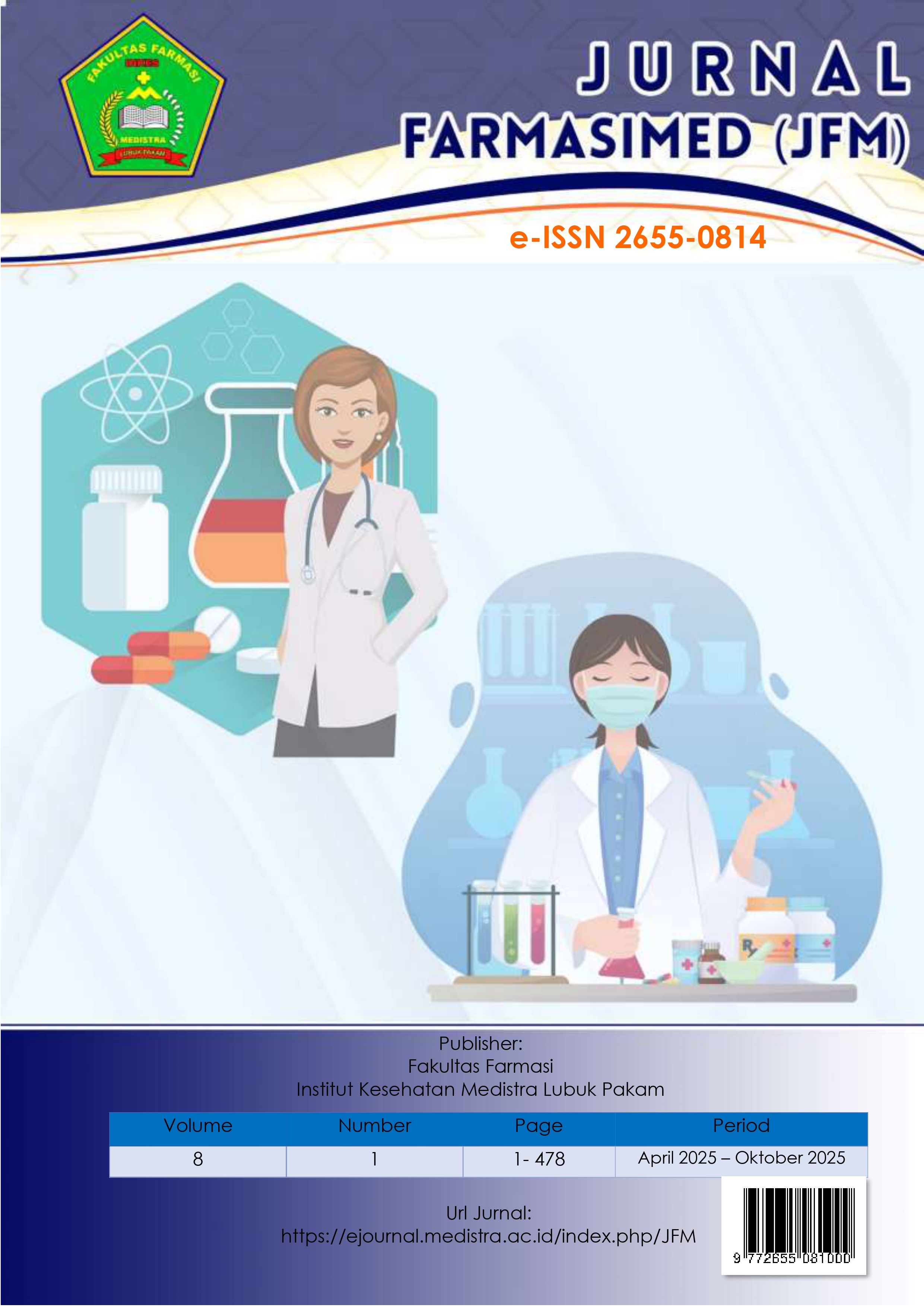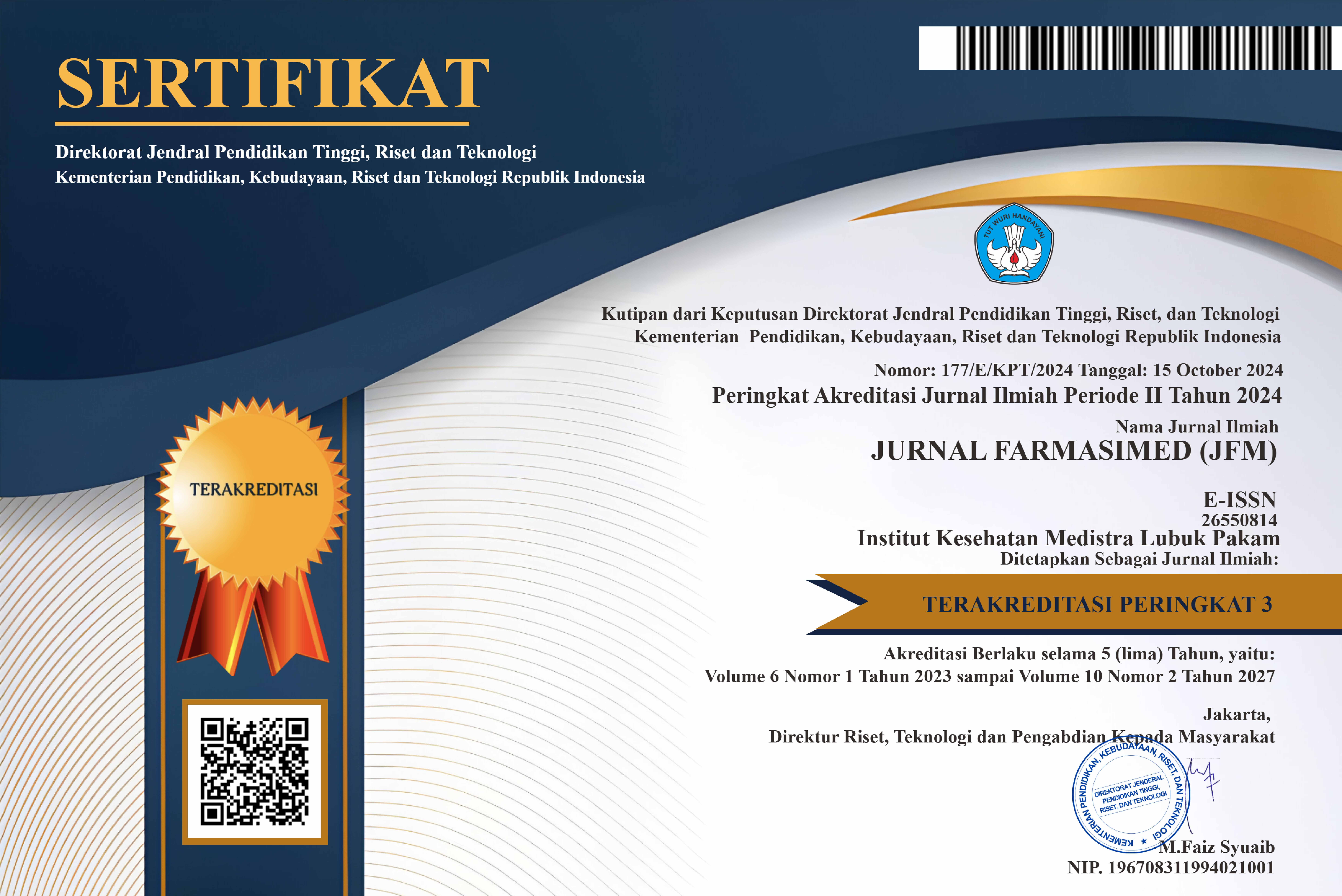Antiinflamation Activity Assay of Ethanol Extract of Rhabdastrella sp Sponge Using Denaturation of Chicken Egg Albumin Protein Method
DOI:
https://doi.org/10.35451/3jvv5b49Keywords:
Moringa oleifera, Clitoria ternatea, Radial Arm Maze, Cognitive function, AlzheimerAbstract
Inflammation is a body defense mechanism by the presence of cell damage against harmful stimuli caused by pathogens, toxic compounds, or irradiation. Drugs that have been used have adverse side effects for the body. The use of natural ingredients is an alternative, one of which is natural ingredients from the sea, namely Rhabdastrella sp. The sponge genus Rhabdastrella has various bioactivities such as anticancer, antimalarial, antibacterial, chemopreventive, anti-inflammatory, antioxidant, cardioprotective, insecticidal, antidiabetic, cytotoxic. Other species of the Genus Rhabdastrella, such as the sponge Rhabdastrella sp. has never been studied. The purpose of this study was to determine the antiinflamation activity of the ethanol extract of the sponge Rhabdastrella sp. The research method was carried out using the method of denaturation of chicken egg protein. The sponge Rhabdastrella sp. was extracted with 96% ethanol. The anti-inflammatory test with protein denaturation used spectrophotometry at a wavelength of 660 nm. concentrations of sample are 50 ppm, 100 ppm, 150 ppm, 200 ppm, and 250 ppm. The positive control comparison used sodium diclofenac with concentrations are 3.12 ppm; 6.25 ppm; 12.5 ppm; 25 ppm; and 50 ppm. The results showed that the ability to inhibit protein denaturation of 20% ethanol extract of Rhabdastrella sp. was obtained at 70.29 ppm, while the IC50 of the ethanol extract obtained was 280.33 ppm. These results were significantly different from the positive control of sodium diclofenac, which was 36.51 ppm. The anti-inflammatory activity of the sample sponge extract was very small because the content of compounds that have anti-inflammatory abilities, including flavonoids, was only about 2%. Based on this, the sponge extract of Rhabdastrella sp. is not potential as an anti-inflammatory.
Downloads
References
[1] D. S. Novika, R. Ahsanunnisa, and D. F. Yani, “Uji Aktivitas Antiinflamasi Ekstrak Etanol Daun Belimbing Wuluh (Averrhoa bilimbi L.) Terhadap Penghambatan Denaturasi Protein,” Stannum : Jurnal Sains dan Terapan Kimia, vol. 3, no. 1, pp. 16–22, May 2021, doi: 10.33019/jstk.v3i1.2117.
[2] M. Mahfur, E. P. Setyowati, S. Wahyuono, and I. Purwantini, “Sponge Hyrtios reticulatus : Phytochemicals and Bioactivities,” Research J. Pharm. and Tech., vol. 15, no. June, pp. 1–7, 2022, Accessed: May 28, 2025. [Online]. Available: https://doi.org/10.52711/0974-360X.2022.00477
[3] R. Pallela and H. Ehrlich, Marine sponges: Chemicobiological and biomedical applications. 2016. doi: 10.1007/978-81-322-2794-6.
[4] K. H. Lai, Z. H. Huang, M. El-Shazly, B. R. Peng, W. C. Wei, and J. H. Su, “Isomalabaricane Triterpenes from the Marine Sponge Rhabdastrella sp.,” Mar Drugs, vol. 19, no. 4, pp. 4–11, 2021, doi: 10.3390/MD19040206.
[5] A. B. Kozhushnaya et al., “Rhabdastrellosides A and B: Two New Isomalabaricane Glycosides from the Marine Sponge Rhabdastrella globostellata, and Their Cytotoxic and Cytoprotective Effects,” Mar Drugs, vol. 21, no. 11, Nov. 2023, doi: 10.3390/md21110554.
[6] D. T. Trang et al., “Rhabdastrenones A-D from the sponge Rhabdastrella globostellata,” RSC Adv, vol. 12, no. 17, pp. 10646–10652, 2022, doi: 10.1039/d2ra01674e.
[7] F. Lv et al., “Rhabdastrellins A-F, isomalabaricane triterpenes from the marine sponge Rhabdastrella aff. distincta,” J Nat Prod, vol. 71, no. 10, pp. 1738–1741, Oct. 2008, doi: 10.1021/np800324v.
[8] P. Sauleau, C. Moriou, and A. Al Mourabit, “Metabolomics approach to chemical diversity of the Mediterranean marine sponge Agelas oroides,” Nat Prod Res, vol. 31, no. 14, pp. 1625–1632, 2017, doi: 10.1080/14786419.2017.1285298.
[9] M. Mahfur, S. Wahyuono, I. Purwantini, and E. P. Setyowati, “Antiplasmodial Activity, Isolation and Structure Elucidation of Steroid Compound from Sponge Hyrtios reticulatus,” Indonesian Journal of Pharmacy, Oct. 2024, Accessed: Jan. 22, 2025. [Online]. Available: https://doi.org/10.22146/ijp.9797
[10] M. Mahfur, A. Kamila, J. F. Abidah, P. O. Samirana, B. D. Hikmawan, and D. Pratimasari, “Antibacterial activity of ethyl acetate extract of symbiont fungus Aspergillus sp. in the sponge Rhabdastrella sp. from Gili Layar Island, Lombok, Indonesia,” J Appl Pharm Sci, vol. 13, no. 11, pp. 144–151, 2023, doi: 10.7324/JAPS.2023.146303.
[11] M. Mahfur et al., “Antibacterial potential of Penicillium nalgiovense from Symbiont Fungal in the Gelliodes fibulata Sponge,” Res J Pharm Technol, pp. 2633–2638, Jun. 2024, doi: 10.52711/0974-360X.2024.00412
[12] Mukhriani, “Ekstraksi, Pemisahan Senyawa, dan Identifikasi Senyawa Aktif,” J. Kesehat., vol. VII, no. 2, p. 361, 2014, [Online]. Available: https://doi.org/10.1007/s11293-018-9601-y
[13] Q. Tang, B. Wan, X. Yuan, A. D. Muscente, and S. Xiao, “Spiculogenesis and biomineralization in early sponge animals,” Nat Commun, vol. 10, no. 1, 2019, doi: 10.1038/s41467-019-11297-4.
[14] A. Shalihah, F. M. Christianty, and F. A. Fajrin, “Anti inflammatory Activity of the Ethanol Extract of Cinnamon (Cinnamomum burmannii) Bark using Membrane Stabilization Method and Protein Denaturation,” Indonesian Journal of Pharmaceutical Science and Technology, vol. 1, p. 9, Jan. 2022, doi: 10.24198/ijpst.v1i1.36323.
[15] A. R. Yadav and S. K. Mohite, “Screening of In-vitro anti-inflammatory and Antibacterial assay of Malvastrum Coromandelianum,” International Journal of Pharma Sciences and Research, vol. 11, no. 4, pp. 68–70, Apr. 2020.
[16] D. Yasothkumar, S. Jayaraman, K. Ramalingam, and P. Ramani, “In vitro Anti-Inflammatory and Antioxidant Activity of Seed Ethanolic Extract of Pongamia pinnata,” Biomedical and Pharmacology Journal, vol. 16, no. 4, pp. 2187–2193, 2023, doi: 10.13005/bpj/2795.
[17] N. A. Nasution, M. Nurilmala, and A. Abdullah, “Seahorse Hydrolisate (Hippocampus kuda) and Anti-Inflammatory Activity Test with Protein Denaturation Inhibition Method,” Jurnal Perikanan Universitas Gadjah Mada, vol. 21, no. 1, p. 47, Jun. 2019, doi: 10.22146/jfs.43699.
[18] M. Walid et al., “Anti-Inflammatory Activity Assay of Ethanol Extract of Agelas cavernosa Sponge using Protein Denaturation Method,” Jurnal Biologi Tropis, vol. 24, no. 4, pp. 452–458, Oct. 2024, doi: 10.29303/jbt.v24i4.7661.
[19] P. Masson and S. Lushchekina, “Conformational Stability and Denaturation Processes of Proteins Investigated by Electrophoresis under Extreme Conditions,” Oct. 01, 2022, MDPI. doi: 10.3390/molecules27206861.
[20] C. R. M. Souza, W. P. Bezerra, and J. T. Souto, “Marine alkaloids with anti-inflammatory activity: Current knowledge and future perspectives,” Mar Drugs, vol. 18, no. 3, 2020, doi: 10.3390/md18030147.
[21] A. Shalihah, F. M. Christianty, and F. A. Fajrin, “Anti-inflammatory Activity of the Ethanol Extract of Cinnamon (Cinnamomum burmannii) Bark using Membrane Stabilization Method and Protein Denaturation,” 2021. [Online]. Available: http://jurnal.unpad.ac.id/ijpst/
[22] Y. X. Goh, J. Jalil, K. W. Lam, K. Husain, and C. M. Premakumar, “Genistein: A Review on its Anti-Inflammatory Properties,” Jan. 24, 2022, Frontiers Media S.A. doi: 10.3389/fphar.2022.820969.
Downloads
Published
Issue
Section
License
Copyright (c) 2025 Mahfur Mahfur, Khafid Mahbub, Dina Achada, Ika Vina Dika

This work is licensed under a Creative Commons Attribution-NoDerivatives 4.0 International License.
Copyright in each article is the property of the Author.

























